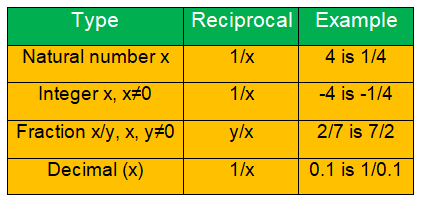FIND RECIPROCAL OF THE NUMBER
What is Reciprocal ?
In maths, reciprocal is simply defined as the inverse of a value or a number.

Find the reciprocal.
|
Numbers 3/4 2/3 -5/17 -6/19 11/8 -13 -19 -1 1 |
Reciprocal of a numbers 4/3 3/2 -17/5 -19/6 8/11 -1/13 -1/19 -1 1 |
Problem 1 :
State the reciprocal of:
|
a) 3/4 b) 2/7 c) 4 d) -1/2 |
e) -2 f) 5/8 g) -5/2 h) -1 |
Solution :
a) 3/4
Reciprocal of 3/4 is 4/3
b) 2/7
Reciprocal of 2/7 is 7/2
c) 4
To consider 4 as 4/1. Reciprocal of 4/1 is 1/4.
d) -1/2
Reciprocal of -1/2 is -2/1. That is -2.
Problem 2 :
Find :
|
a) 2/3 ÷ 1/6 b) 5/7 ÷ 1/3 c) 3/4 ÷ (-1/2) d) 4/5 ÷ 3 |
e) 1/4 ÷ 1 2 /3 f) 2 3/4 ÷ 2/3 g) 1 1/2 ÷ (-3/4) h) 3 1/5 ÷ 1 1/3 |
Solution :
a) 2/3 ÷ 1/6
By changing the division sign as multiplication, we can change the division sign as multiplication and write the reciprocal of second fraction.
= 2/3 x (6/1)
= 2 x (2/1)
= 4/1
= 4
b) 5/7 ÷ 1/3
= 5/7 x (3/1)
= (5 x 3) / (7 x 1)
= 15/7
Converting into mixed fraction, we get
= 2 1/7
c) 3/4 ÷ (-1/2)
= 3/4 x (-2/1)
= (-3 x 2)/(4 x 1)
= -3/2
Converting into mixed fraction, we get
= -1 1/2.
d) 4/5 ÷ 3
= 4/5 ÷ (3/1)
Convert division sign as multiplication and changing the second fraction as its reciprocal.
= 4/5 x (1/3)
= (4 x 1) / (5 x 3)
= 4/15
e) 1/4 ÷ 1 2 /3
Converting the mixed fraction 1 2/3 as improper fraction, we get
1 2/3 = 5/3
1/4 ÷ 1 2 /3 = 1/4 ÷ 5/3
= 1/4 x (3/5)
= (1 x 3) / (4 x 5)
= 3/20
f) 2 3/4 ÷ 2/3
Converting 2 3/4 as improper fraction, we get
2 3/4 = 11/4
= 11/4 ÷ 2/3
= 11/4 x (3/2)
= (11 x 3) / (4 x 2)
= 33/8
Converting into mixed fraction, we get
= 4 1/8
g) 1 1/2 ÷ (-3/4)
Converting 1 1/2 as improper fraction, we get
1 1/2 = 3/2
1 1/2 ÷ (-3/4) = 3/2 ÷ (-3/4)
= (3/2) x (-4/3)
= (-3 x 4) / (2 x 3)
= -2
h) 3 1/5 ÷ 1 1/3
Converting mixed fractions 3 1/5 as improper fraction, we get
3 1/5 = 16/5
Converting mixed fractions 1 1/3 as improper fraction, we get
1 1/3 = 4/3
3 1/5 ÷ 1 1/3 = (16/5) ÷ (4/3)
= (16/5) x (3/4)
= (16 x 3) / (5 x 4)
= (4 x 3)/5
= 12/5
= 2 2/5
Problem 3 :
A vitamin C tablet contains 1/40 of a gram of vitamin C. You take 1 1/2 tablets every day. How many grams of vitamin C do you take every day?
Solution :
Quantity of vitamin C = 1/40 grams
Daily consumption = 1 1/2 tablet ==> 3/2
Quantity of vitamin C he consumes = 1/40 of 3/2
= 1/40 x (2/3)
= 1/60 grams of vitamin C.
Problem 4 :
A science experiment calls for 3/4 cup of baking powder. You have 1/3 cup of baking powder. How much more baking powder do you need?
Solution :
Amount of baking powder needed = 3/4 cup
Amount of baking powder i have = 1/3 cup
Amount of baking powder needed = 3/4 - 1/3
= (9 - 4)/12
= 5/12 cups
Problem 5 :
Write the division problem and solve it using a model.
a. How many two-thirds are in three?
b. How many halves are in fi ve halves?
c. How many four-fi fths are in eight?
d. How many one-thirds are in seven halves?
e. How many three-fourths are in fi ve halves?
Solution :
a.
two third = 2/3
Number of two thirds in 3 = 3 ÷ (2/3)
= 3 x 3/2
= 9/2
= 4.5
Approximately 5 two thirds.
b.
Half = 1/2
Number of five halves = 5 1/2 ÷ 1/2
= 11/2 ÷ 1/2
= 11/2 x 2/1
= 11 five halves
c. How many four-fi fths are in eight?
four fifts = 4/5
number of four fifts = 8 ÷ 4/5
= 8/1 x 5/4
= 2 x 5
= 10
So, 10 four fifts are in eight.
d. How many one-thirds are in seven halves?
One thids = 1/3
Seven halves = 7 1/2
= 15/2
Number of one thirds in sevene halves = (15/2) ÷ 1/3
= 15/2 x 3/1
= (15 x 3)/(2 x 1)
= 45/2
= 22.5
Approximately 23 one thirds are in seven halves.
e. How many three-fourths are in fi ve halves?
Three fourth = 3/4
five halves = 5 1/2
= 11/2
Number of three fourths in five halves = 11/2 ÷ 3/4
= 11/2 x 4/3
= (11 x 2)/3
= 22/3
= 7.3
Approximately 7 three fourths are in five halves.
Recent Articles
-
Finding Range of Values Inequality Problems
May 21, 24 08:51 PM
Finding Range of Values Inequality Problems -
Solving Two Step Inequality Word Problems
May 21, 24 08:51 AM
Solving Two Step Inequality Word Problems -
Exponential Function Context and Data Modeling
May 20, 24 10:45 PM
Exponential Function Context and Data Modeling